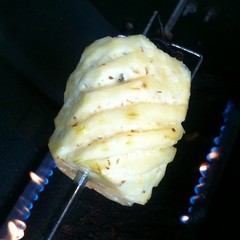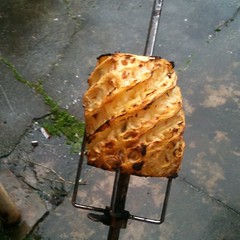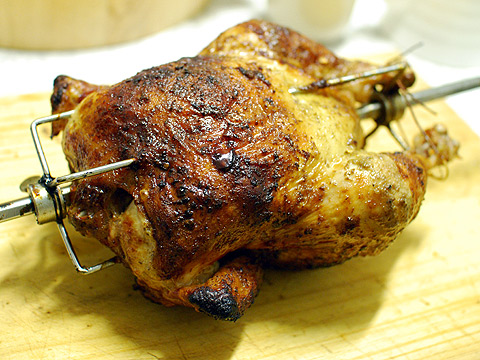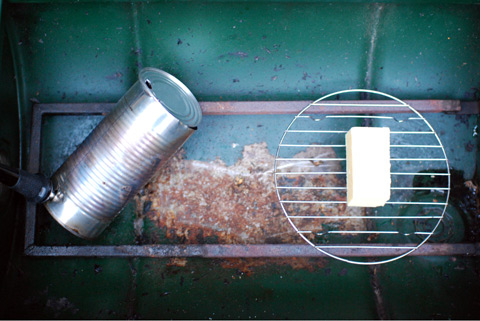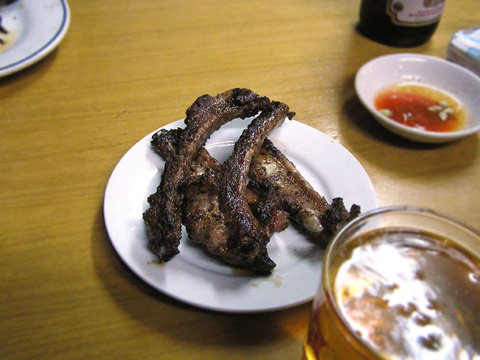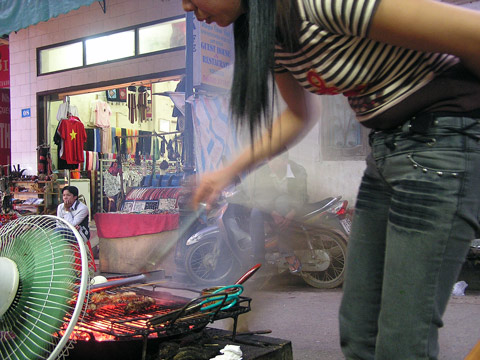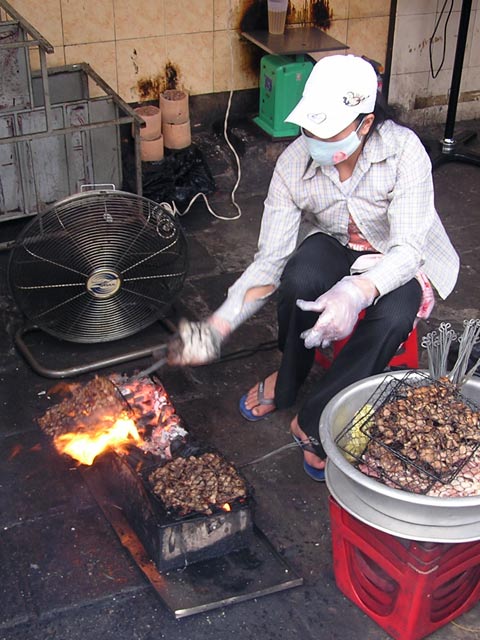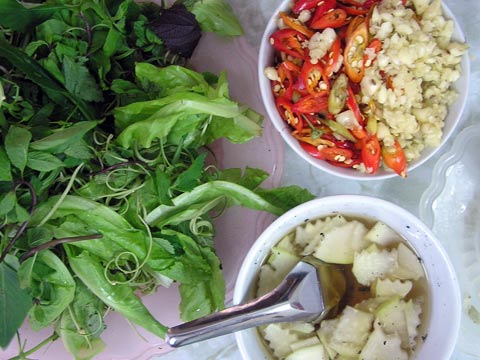In case you were wondering, it takes about 35 minutes to cook a pineapple on a rotisserie until soft and hot to the core, developing a nice char.
Posts Tagged → barbecue
Rotisserie = home
I’ve moved into the house of an expatriate Slovenian bootlegger and as soon as I’ve set up a rotisserie, it feels like home again.
If there is a single item of cookware that I could be trapped with on a desert island, it would be the rotisserie, although only if there was an indigenous chicken or lamb population. Cooking a whole chicken any other way cheats you of pleasure. The above chicken was rubbed with salt, ground cumin and pepper. There is no recipe, just add any quantity of those two spices and mineral together, rub it on a plump dead chicken and rotate the chicken over fire.
There’s been multiple posts of late rueing the mutual slump in food blogging mojo in Australia. As I mentioned earlier, I’ve been renovating a house and the only thing less entertaining than manual labour is having someone tell you about manual labour in great detail when you’re expecting some sort of food narrative. How home renovation manages to survive as a genre of television is bewildering to me. Then again, it’s not as if I’ve been posting frequently or in depth at lastappetite.com in the preceding months.
So what has happened to Australian food blogging? Is it part of a wider trend or just the people whom I read? Is the smoke haze affecting the food? Financial crisis? I wrote about food blogging being dead at the start last year but maybe it is actually coming to fruition.
Cold smoking at home: Convert your Weber for $10
I seem to have infected my friends with the charcuterie virus.
What started with the occasional foray into a simple pork and garlic sausage is now ending in converting garden sheds into full-sized smokehouses to smoke lanjager and prosciutto. I had a recent discussion about the feasibility of airing ham beneath your average Australian home. It’s utter madness. The only thing that keeps my psychosis from blossoming is limited space in my apartment.
A limitation that I’m learning to overcome with ingenuity.
Converting your BBQ into a cold smoker
Cold smoking (smoking foods below 37°C/100°F) can be achieved through a few different methods: lighting a fire in large room to disperse the heat; cooling the smoke on the way into wherever you are hanging the food to be smoked; or generating as little heat as possible to create smoke. Smokehouses are the first tactic some of which include refrigeration to cool the smoke on the way in. Various barbecue forums mention using trays filled with ice to cool your backyard smoker (or smoking outside in the snow, further north), which constitutes the second method. The third method just needs a hot and very concentrated heat source
All you need to provide that heat is a brand new soldering iron ($9.99!). An empty tin can with the lid still partially attached will suffice for a smoke box, along with sawdust and a barbecue with a lid. A Weber-style kettle barbecue is ideal. Don’t use an old soldering iron: lead solder and food do not mix.
Punch a hole in the tin can, stick the soldering iron in and fill the can about a third full of clean sawdust. Turn on the soldering iron and smoke away. That’s all. I burnt the can over an open flame just in case it was lined with a lacquer but I doubt that it was.
The smoker maintained temperature in the barbecue at 18 degrees Celcius (64°F), 4 degrees above the ambient temperature. At that temperature, it’s cold enough to smoke butter. After two hours, two thirds of the handful of sawdust had burnt down to charcoal suggesting that for longer smoking, the smoker will need to be refilled with sawdust every three hours or so.
My test cheese to cold smoke, alleged to be “Australia’s tastiest cheese”; definitely Australia’s most inadvertently racist cheese. I used hickory sawdust.
After two hours, the cheese had taken on a heavy hickory smoke flavour but hadn’t developed the reddish color that comes from longer smoking. It is by far the best thing that can happen to Coon cheese.
More testing to come.
Banh Mi Doner Kebab
I’ve had many a conversation with family and friends whether it is possible to combine the two of the world’s perfect foods, laksa and souvlaki, into a single ideal entity – souvlaksa – but still have not worked out the mechanics of keeping a noodle soup/garlic sauce mixture contained within a pita without resorting to either gel or foam. Herve This has not returned my rambling, incoherent emails. It was with much interest that I approached the banh mi doner kebab, imagining that somewhere in Hanoi, somebody else has been thinking along similar and no less ambitious lines.
Their crisp white toque was almost as impressive and bewildering as their rotating elephant’s foot of miscellaneous kebab meat. I’m still unsure what Germany’s greatest man of letters has to do with it at all but it seems to serve as an appropriately Faustian warning towards those who choose to sell their soul to street side meat barbecue.
The end product was just an average kebab, pork being the rotating meat in question. None of the banh mi’s freshness or crunch but with the addition of recently pickled red cabbage and mayonnaise.
Location: Banh Mi Doner Kebab joints are coincidentally located next to where foreigners in Hanoi do vast amounts of drinking: at the “Bia Hoi Corner” (Corner of Ta Hien and Luong Ngoc Quyen) in the Old Quarter.
The Ribs of Sapa
My worthless superpower is the ability to step into any city in the world and find a joint that serves barbecued pork ribs. Sapa in Northern Vietnam is not a street food mecca but ribs were there to be unearthed, alongside the usual assortment of chicken parts and other innards prepped for the grill on the street just north of Sapa’s central market. The ribs had the heavy charcoal flavour that comes from a long period of rest in a sugar-packed marinade followed by a short and brutal blast over the coals.
One of the barbecue innovations that you see around Vietnam is superheating the charcoal barbecue with an electric fan. I never saw this in Cambodia (possibly as a result of extortionate electricity prices), but it seems to be more common in Thailand as well, especially as a technique for heating a charcoal-fuelled wok burner.
Cha Cha Cha
bun cha is a blunt instrument. For all the subtlety engendered by Vietnamese cuisine, bun cha acts as a counterpoint: blackened rissoles of pork teamed with charred slices of pork belly in a thin fish sauce, vinegar and sugar stock with sides of bun noodles and assorted greens. Depending on season, either slices of green papaya or chayote (choko) are set afloat upon the stock.
The emphasis however is on the barbecued meat. After mixing components, loose charcoal from the pork is suffused through and suspended in the stock, leaving a thin black ring of charred detritus around the bowl and clinging to every slurp of noodles. The dish is omnipresent at lunchtime in the north of Vietnam, tough to find in the south, practically impossible to stumble upon overseas without guidance or a moment of serendipity. The above bowl was from Bun Cha Dac Kim on Hang Manh Street, Hanoi, not quite “utter bollocks” as one of my favourite food writers denounced them but certainly not the best bowl. The bun cha at 20 Ta Hien St is a much better bet – their fish sauce is punchy and lively, and leaves Dac Kim in its fragrant wake.
I’m beginning to suspect that the quality of food in Vietnam is inversely proportional to the height of the plastic chairs at the restaurant or stall. If a restaurant has stools short enough for your elbows to knock into your knees each time you slurp at your bun then it’s a good find; if plastic chairs are absent then all the better. I’m not sure how folding metal tables work into this equation but they’re somehow vital to it functioning at all.
What Dac Kim lacks in vim, it compensates with bulk. The greens are plated a foot high, the damp bun noodles weighing in at about two pounds, and a spare bowl of stock and papaya is at hand just in case your bowl runs dry. I noticed a trend down south in Veitnam for pho joints to list that “Bill Clinton ate 2 bowls” on the door, regardless of whether he ate there at all. I’m hoping that Dac Kim will follow the trend and list “Bill Clinton ate 2 bowls, then lapsed into a food-related coma”.
Location: Bun Cha Dac Kim, 1 Hang Manh St., Hanoi. A better bowl can be found at Bun Cha, 20 Ta Hien St. hanoi.
Price: 35000 VND with a plate of spring rolls for good measure.
